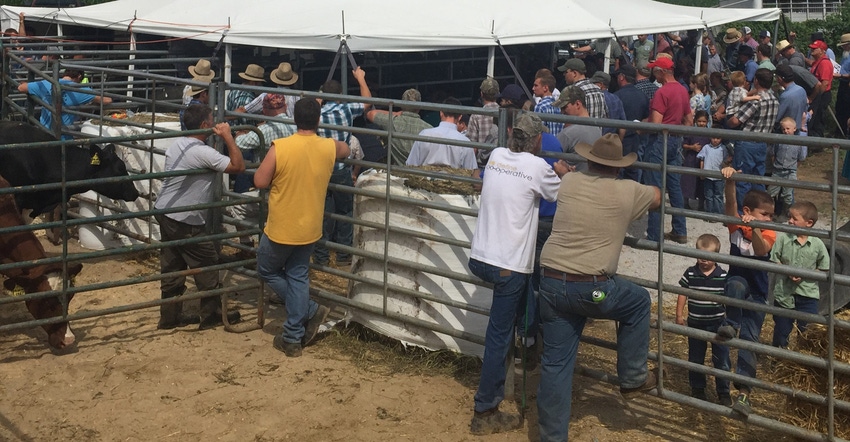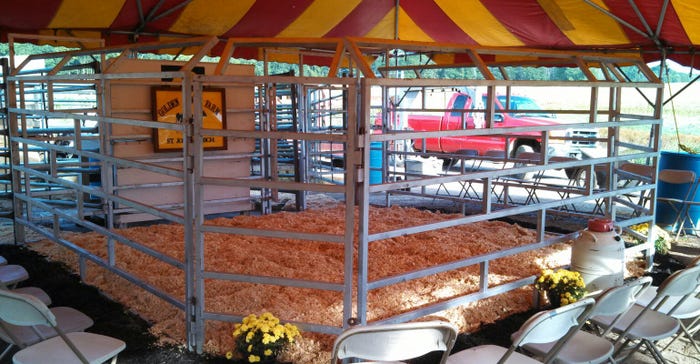March 15, 2018

It can take years for a dairy farmer to be ready to sell the cows, according to Chad Kreeger, who manages the Dairy Cattle Marketing Team for United Producers Inc. along with Paul Warner. For some farmers, the current cycle of back-to-back years of low milk prices has made that decision more pressing.
“It’s very emotional; it’s life-changing when they’ve dealt with the cows every day to not having them,” he says. “It’s a process they’ll have to go through, and when they ask, ‘When’s the right time to sell my cows?’ Our response always is when you’re ready to.”
Kreeger believes at this point dairy farms are falling into two camps: farms that are going to keep milk cows through the good times and the bad, and the ones that will be exiting the business. These farms are under financial distress, or are nearing retirement and do not have another generation to take over the dairy. Many have been thinking about exiting the business for some time.
 VALUES DROP: Chad Kreeger says cattle values have dropped over the last six months with depressed dairy markets and more herds being dispersed.
VALUES DROP: Chad Kreeger says cattle values have dropped over the last six months with depressed dairy markets and more herds being dispersed.

Kreeger says most of the calls he receives are from farmers milking 200 to 400 cows who are pursuing exiting the business. “The farmers that have been thinking about it; continued low prices have just helped make their decision that it’s time to do something other than milking cows,” he says.
More cows to market
Kreeger says cattle values have dropped over the last six months with depressed dairy markets and more herds being dispersed. “Currently there’s probably more cattle available on the market than we’ve seen demand for, so we’ve seen a drop in price quite substantially in the last four to five months.”
Last fall UPI was marketing fresh heifers between $1,800 and $2,200; six months later, sale prices are about 25% lower. The decline in prices is an even higher percentage for milking herds, heifers and calves. “The heifer market has mimicked late fall of 2008, end of 2009,” he says. “There’s a lot of heifers in the pipeline, and that will continue to keep the cattle price down as far as replacement heifers.”
While the cow herd is one of the largest assets a dairy farmer has, Kreeger encourages farmers not to wait for the market to improve if every month they’re getting further into the red. “If you keep the cows because they’re not worth as much, but you’re continuing to go backward every month by keeping them, pretty soon it doesn’t matter what the cows are worth, you’re still further behind,” he says. “It’s about the financial health of the entire farm, not just the cow value.”
Once the call is made for an entire herd dispersal, Kreeger says the process takes about a month before the auction, but they have coordinated sales in as little as a week. “You only have one time to sell your herd. ‘You don’t get a practice run at it’ is what Paul has always said and it is how we plan every sale. So anything we can do to increase the success rate with more time and planning helps the end result,” he says.
 FAMILY FIRST: Kreeger believes the best decision for farmers considering selling is to do what’s best for themselves and their family.
FAMILY FIRST: Kreeger believes the best decision for farmers considering selling is to do what’s best for themselves and their family.

According to Kreeger, each sale is unique. “We work with the farmer and make our recommendations based on the current market and situation on how to conduct the sale.”
Kreeger says more cows appear to be going to slaughter in general, but there is a very noticeable difference in the number of cows that are going to slaughter in herd dispersal situations. “A much higher of a percentage of cows in the herds that are dispersing are going to slaughter right off the bat currently than they have before, more so than ever in my career,” he says.
Life after cows
The end of the dairy herd doesn’t mean the end of a farmer’s career. According to Kreeger, many of the farmers he works with continue to find ways to stay in agriculture after selling off the herd. “There’s been a few lately that are going to sell everything and just leave the business altogether, but a lot of them continue to retain the land and may keep their heifers back and raise them, feed some steers and continue to crop-farm. It just depends on the situation,” he says. Kreeger believes the best decision for farmers is to do what’s best for themselves and their family. “Your health and your family’s well-being is the most important thing, not necessarily keeping the cows,” he says.
USDA confirms fewer dairies
The USDA confirms the trend of more cows on fewer farms is continuing. USDA says there are 1,600 fewer dairy farms in the country. Wisconsin lost the most dairy farms in 2017 with 430 fewer dairies, followed by Ohio, which lost 180 dairy farms. Michigan had 60 fewer licensed producers.
The recent national milk production report shows the number of licensed producers at 40,219 compared to 41,819 in 2016. The number of milk cows for January nationwide increased by 5 million from 2017 to 8.74 million.
USDA says Michigan dairy herds increased production by 1.2% in January to 942 million pounds of milk. Production per cow increased 0.4 pound to 71 pounds, and the herd increased by 3,000 head to an estimated 428,000 head for January.
Heslip works as the Michigan anchor and reporter for Brownfield Ag News.
About the Author(s)
You May Also Like




